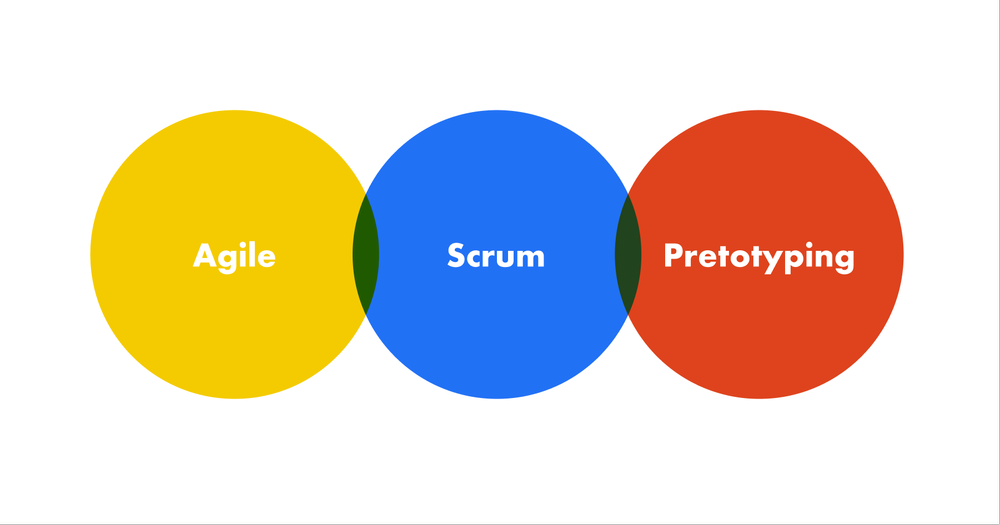Agile + Scrum + Pretotyping: the holy trinity of innovation?
When we work with companies to embed pretotyping into their innovation process, we are never working with a blank slate. Teams use all sorts of methodologies - Lean, Amazon’s ‘working backwards’ method, human-centred design, design thinking, design sprints - to scaffold their innovation process. One of the most common combinations of methodologies we come across is the Agile + Scrum dream team. Agile and Scrum go together like two peas in a pod - but it’s about time for Pretotyping to join the party.
As a set of values and principles, Agile works as a foundation on top of which Scrum operates. Scrum is more process-oriented, offering clear steps, roles and responsibilities to help teams build protoypes efficiently and effectively. So where does pretotyping come in? As both a set of principles and a process that focuses on validating ideas early, quickly, and at low cost, pretotyping helps to bridge the gap between Agile’s philosophy and Scrums’ process. It offers a toolbox of concrete methods and techniques to ensure that innovation is grounded in data and effective experimentation, with customers at the centre of each experiment, and led by a democratic approach to innovation teams. This all combines to support the underlying principles of both Agile and Scrum, which value efficiency, democracy, and a customer-centric approach.
Agile pretotyping
Agile operates according to a set of four principles which guide decision-making. Pretotyping shares these principles, and offers methods that help enact them in concrete and measurable ways. In fact, it even has its own manifesto inspired by the Agile manifesto. Let’s take a look at how pretotyping interacts which each of Agile’s four principles:
1. Individuals and interactions over processes and tools
Pretotyping helps uphold this principle by supporting teams to figure out which individuals and interactions actually matter to customers. Pretotyping is less focussed on finding the right processes and tools straight away - instead, it uses iteration and experimentation to determine which interactions need improving, based on real customer data, not the opinions of those in the company.
2. Working software over comprehensive documentation
Pretotyping also preferences action over documentation, and uses experimentation to figure out which features are the most valuable for customers. Importantly, pretotyping discourages sinking time and money into developing software (or any product or service) without the data needed to validate the idea. By running experiments and gathering data, pretotyping allows teams to build the products and services they know customers actually want.
3. Customer collaboration over contract negotiation
Customer collaboration also gets to the heart of pretotyping. Each experiment is designed to gather data from customers that tells innovation teams which products and services will serve their customers’ needs, and which won’t. Pretotyping is all about working out what customers actually want, and clearly defining what success looks like for customers, according to their own experience - not according to the opinions of company heads or innovation teams. Using the lean canvas, each pretotype has to be clear on what success looks like for each experiment, defined according to a customer-centric methodology.
4. Responding to change over following a plan
With every pretotype, teams have to be responsive to the data they receive. Experiments need to change as new information is received - iteration and embracing failure is core to pretotyping, and celebrating the knowledge that comes through change helps innovation teams to develop products and services they know customers will love, using data they gather through experimentation.
Pretotyping and Agile work beautifully in parallel. The ‘data over opinion’ principle of pretotyping helps to ground Agile’s values in evidence, rather than descending into affinity mapping or dot voting, which is just a kind of opinion. Pretotyping helps Agile and Scrum teams decide which product or service to develop, and helps teams keep customers at the centre of innovation by constantly seeking data in order to iterate and develop ideas.
Scrumming it.
Scrum’s focus on breaking projects down into a series of time-limited ‘sprints’ works beautifully with pretotyping, which seeks to break down ideas into iterative experiments in order to gather the most helpful customer data. Like pretotyping, Scrum helps reduce the risk and potential cost of innovation by working iteratively, taking smaller steps, and gathering feedback and information before moving onto the next stage of the process.
Pretotyping particularly supports Product Owners to gather the evidence they need to own the development of new products end-to-end, using data gathered from experiments to advocate for the needs of the customers. Pretotyping makes the Scrum process even more democratic, allowing data - not opinion - to form the basis of decision-making, and empowering teams to champion the ideas that have been proven to work, rather than being left with nothing but opinion to back them up.
Pretotyping asks teams to answer the question: “How can we test this idea for $0, in under 24hrs?” This emphasis on creating experiments that can be up-and-running as quickly as possible helps remove any blockers that may arise as part of the Scum process, and allows teams to take action within sprints in order to make stronger, faster, more evidence-based decisions.
A holy trinity.
Since pretotyping is an active process that is founded on strong principles, it works to scaffold both Agile and Scrum. As a philosophy, pretotyping puts customers at the center of innovation, and empowers teams to advocate for the ideas they know will work, using data instead of opinion. As a process, pretotyping offers structured steps and methods that allow its principles to play out in concrete ways. There is no guesswork in pretotyping - instead, there are clear steps to take to get answers and make decisions. Nothing is left to chance, and everyone can own every step of the process.
Pretotyping, Agile, and Scrum work together to make innovation more democratic, and more customer-focussed. Together, the three methodologies support each other and support the innovation process to help teams ideate and iterate using solid principles, clear processes, and - most importantly - reliable data
*Ready to integrate pretotyping into your innovation process? Contact Leslie to discuss training for your team or company, or sign up for a free preview of our online pretotyping course.


